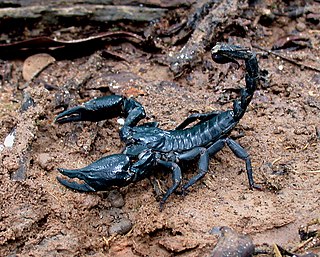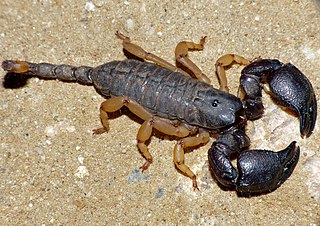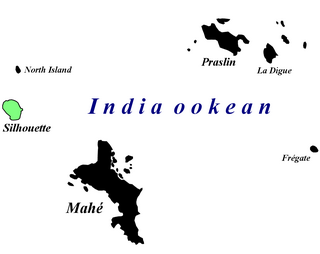
Scorpions are predatory arachnids of the order Scorpiones. They have eight legs and are easily recognized by a pair of grasping pincers and a narrow, segmented tail, often carried in a characteristic forward curve over the back and always ending with a stinger. The evolutionary history of scorpions goes back 435 million years. They mainly live in deserts but have adapted to a wide range of environmental conditions, and can be found on all continents except Antarctica. There are over 2,500 described species, with 22 extant (living) families recognized to date. Their taxonomy is being revised to account for 21st-century genomic studies.

Pseudoscorpions, also known as false scorpions or book scorpions, are small, scorpion-like arachnids belonging to the order Pseudoscorpiones, also known as Pseudoscorpionida or Chelonethida.

Amblypygi is an order of arachnid chelicerate arthropods also known as whip spiders or tailless whip scorpions, not to be confused with whip scorpions or vinegaroons that belong to the related order Thelyphonida. The name "amblypygid" means "blunt tail", a reference to a lack of the flagellum that is otherwise seen in whip scorpions. Amblypygids possess no silk glands or venomous fangs. They rarely bite if threatened, but can grab fingers with their pedipalps, resulting in thorn-like puncture injuries.

Uropygi is an arachnid order comprising invertebrates commonly known as whip scorpions or vinegaroons. They are often called uropygids. The name "whip scorpion" refers to their resemblance to true scorpions and possession of a whiplike tail, and "vinegaroon" refers to their ability when attacked to discharge an offensive, vinegar-smelling liquid, which contains acetic acid. The order may also be called Thelyphonida. Both names, Uropygi and Thelyphonida, may be used either in a narrow sense for the order of whip scorpions, or in a broad sense which includes the order Schizomida.

Reginald Innes Pocock F.R.S. was a British zoologist.

Nepidae is a family of exclusively aquatic Heteropteran insects in the order Hemiptera. They are commonly called water scorpions for their superficial resemblance to scorpions, due to their raptorial forelegs and the presence of a long slender process at the posterior end of the abdomen, resembling a tail. There are 14 genera in the family, in two subfamilies, Nepinae and Ranatrinae. Members of the genus Ranatra, the most widespread and species-rich genus, are sometimes called needle bugs or water stick insects as they are slenderer than Nepa.

The desert long-eared bat is a species of vesper bat found in North Africa and the Middle East.

The Buthidae are the largest family of scorpions, containing about 100 genera and 1339 species as of 2022. A few very large genera are known, but a high number of species-poor or monotypic ones also exist. New taxa are being described at a rate of several new species per year. They have a cosmopolitan distribution throughout tropical and subtropical environments worldwide. Together with four other families, the Buthidae make up the superfamily Buthoidea. The family was established by Carl Ludwig Koch in 1837.
The taxonomy of scorpions deals with the classification of this predatory arthropod into 13 extant families and about 1,400 described species and subspecies. In addition, 111 described taxa of extinct scorpions are known.

Heterometrus, whose members are also known by the collective vernacular name giant forest scorpions, is a genus of scorpions belonging to the family Scorpionidae. It is distributed widely across tropical and subtropical southeastern Asia, including Indonesia, Brunei, Malaysia, Myanmar, Philippines, Singapore, Cambodia, Laos, Thailand, Vietnam, India, and China (Hainan). It is notable for containing some of the largest living species of scorpions.

Vaejovidae is a family of scorpions, comprising 25 genera and 227 species, found in North America. The species of the genus are found in Mexico and the southern United States, and Paruroctonus boreus is found in Canada and is the northernmost species of scorpion in the world.

Buthoidea is the largest superfamily of scorpions. Its members are known as fat-tailed scorpions and bark scorpions. A few very large genera are known, but a high number of species-poor or monotypic ones also exist. They occur in the warmer parts of every major landmass on Earth, except on New Zealand. The superfamily was established by Carl Ludwig Koch in 1837.

Gondwanascorpio emzantsiensis is an extinct Gondwanan scorpion that lived 360 million years ago in the Devonian. Its fossil remains, clearly showing pincer and sting, were discovered in rocks of the Witteberg Group near Grahamstown in South Africa. At present, this scorpion is the oldest known land-dwelling animal from Gondwana, which in Devonian times was separated from Laurasia by a deep ocean. At the time, the fossil site was only 15° from the South Pole, but rather than arctic-like tundra, the region was probably wooded, providing ample insect life for food. Previously, only two scorpion species were known from the late Devonian – Hubeiscorpio gracilitarsus from China and Petaloscorpio bureaui from Canada. The species was described by Robert Gess of Wits University in the journal African Invertebrates. The specific epithet derives from umZantsi, the isiXhosa word for "south", sometimes used for South Africa.

Belisarius is a genus of scorpions belonging to the family Belisariidae. The species of this genus are found in Southern Europe.

Scorpionidae is a family of burrowing scorpions or pale-legged scorpions in the superfamily Scorpionoidea. The family was established by Pierre André Latreille, 1802.

Hormuridae is a family of scorpions in the order Scorpiones. There are about 10 genera and more than 90 described species in Hormuridae.

Afrolychas braueri, commonly known as the Seychelles forest scorpion, is a species of scorpion in the family Buthidae. It is currently thought to survive only on Silhouette Island, Seychelles, although the species was historically found on two additional Seychellois islands. This scorpion lives in leaf litter in forests that are largely unaffected by invasive plant species. It is a small yellowish-brown scorpion with three prominent keels on the dorsal surface of its mesosoma, which distinguishes it from other scorpions. While not much is known about the Seychelles forest scorpion's ecology due to the paucity of sightings, it is known to rely solely on its venom to capture its prey and defend its young. Its venom is not dangerous to humans.















